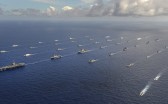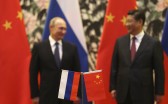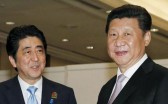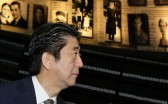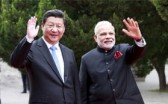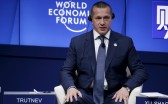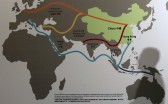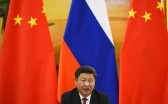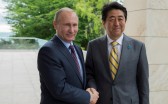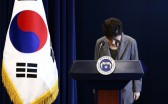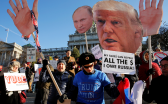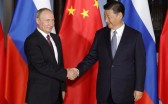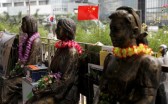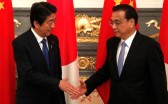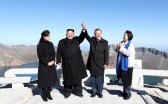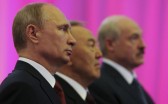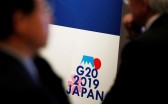Japan-Russia relations started gaining momentum from the beginning of 2016, and even for optimistic observers of that relationship, the tempo of activation that we see now is amazing. It all started in 2012 when Putin, running to become president again in March, held a press conference just a few days before the election, and said that “when elected as president, I want to improve relations with Japan, by substantially strengthening economic ties, and by resolving territorial problems through the principle of ‘hikiwake’ to be defined as ‘neither side loses.’” That was a surprising statement for a Russian leader because Russian public opinion shows no sign of support for any territorial concessions.
When Abe was reelected prime minister in December 2012, he immediately began preparing his Russian policy and made his “initiation” trip to Moscow in April 2013. After a complete suspension of negotiations for two years due to the Crimean and Ukrainian crisis, negotiations were reactivated from the beginning of 2016. They took unmistakable shape at the Sochi summit in May, gained momentum through the Vladivostok summit in September, and with the build-up to the Yamaguchi summit in December, they now seem to have acquired an irreversible character.
Abe is determined to advance economic ties. The large-scale business delegation he took with him in April 2013, the eight-point program he proposed in Sochi in May 2016, the forward-looking speech he made at the “Eastern Economic Forum” in Vladivostok in September, and the special assignment granting an additional portfolio “in charge of Russian affairs” to Seko Hiroshige, minister of economy and industry, all these are unmistakable signs of strong encouragement for Japan-Russia economic relations.
What is more uncertain is what kind of resolution Abe and Putin can find on the territorial problem. Abe’s concise but invigorated press statement after the May Sochi summit that he “found a positive response toward a breakthrough from President Putin, agreed with him to resolve this issue between the two leaders, and also to resolve this issue through a ‘new approach’” was practically the only open sign given to the public. No information is available to the public about the contents of the tête-à-tête meeting with only the interpreters present, half an hour in Sochi in May and one hour in Vladivostok in September.
A clue may be found in the September 23 Yomiuri Shimbun article, asserting that “Abe is not going to request a solution of ‘four islands in a bunch,’ is satisfied first with the transfer of the two smaller islands of Habomai and Shikotan, and will be ready to continue the negotiations on Kunashiri and Etorofu after the conclusion of a Peace Treaty while implementing joint economic activities and free [people-to-people] exchanges on these islands.” The overall direction shown in this article is perceived by many observers to reflect Abe’s views. But did Putin offer any sign of agreement to this line? Although the format clearly indicates that Abe does not insist on a “four islands in a batch” solution, there is too much vagueness to pin down the precise solution.
I have already made my views known in public. On July 18, 2013 Alexander Panov— former ambassador to Japan, with whom I worked closely from the middle of the 1980s—and I published a joint proposal in Nezavisimaya Gazeta. We proposed a “two plus alpha” solution, based on actual proposals exchanged in the negotiations:
• “Two” comes from the 1956 Joint Declaration, Article 9—the transfer of Habomai and Shikotan to Japan after the conclusion of the peace treaty.
• “Alpha” applies to Kunashiri and Etorofu. The idea dates back to November 1998, when President Yeltsin proposed to Prime Minister Obuchi to create a “Special Joint Economic Zone,” with a possibility of a “joint legislature” on the four islands. This idea is now attributed to Kunashiri and Etorofu.
• All other difficult issues, such as how to resolve the question of sovereignty or border demarcation, are not resolved by this joint proposal. These difficult issues are entrusted to the those who are now responsible for the negotiations.
The Yomiuri article and the Panov-Togo joint proposal clearly indicate the same direction. As such, the newly emerging Abe approach cannot but be welcomed. Will Abe-Putin’s new direction really materialize? I sincerely hope so, but there are several barriers the two governments have to overcome in order to finally resolve the territorial issue.
Whether the government of Japan will be able to convince the “conservative-fundamentalists” inside Japan of the necessity of this flexible approach to resolve the territorial issue poses the first barrier to Abe’s success. The group considers that “this is a question of justice for the Japanese people, and therefore the only solution is to let Russia accept the transfer of four islands, or at least, their sovereignty; the maximum concession which Japan made was the Kawana proposal of April 1998, and therefore the only solution which Japan may adopt is to wait until this minimal ‘four islands in a batch’ solution is accepted by Russia.” To some readers, this argument may sound archaic and lacking completely in recognition of reality. But the force of nationalism to support this position can be ignited anytime and anywhere.
One useful counter-argument against those “fundamentalist-nationalists” is to remind them that Japan has missed at least twice a decisive opportunity for a breakthrough. It was precisely Japan’s attachment to the “four islands in a batch” theory which crushed that opportunity. The first real window of opportunity was opened at the time of the demise of the Soviet Union and emergence of the Russian Federation in 1991-1992. Then Russia lost half of its population and one quarter of its territory, by sheer disintegration. Japan was still at the height of its bubble economy when the United States, clearly the number one player in winning the Cold War, looked on Japan as potentially the greatest threat because of its gigantic economic power and the perception that Japan was not playing by the same rules. Furthermore, the newly emerged Russian Federation under Boris Yeltsin had a clear vision to create a democratic Russia based on a market economy. “Western countries,” including the United States, Europe, and Japan, became diplomatic objectives with which to seek cooperation. With urgency for cooperation, Foreign Minister Kozyrev and his vice-minister Kunadze visited Japan in March 1992, and after the official meeting held a confidential and un-official meeting with Foreign Minister Watanabe Michio. The content of the proposal made by the Russian side was not disclosed for two decades, but it became known recently, starting with leaks from Russian sources.
The Russian side proposed in 1992 a new process of negotiations: first, to negotiate the transfer of Habomai and Shikotan and to formulate the transfer in treaty form (“initial” it and freeze it, so to speak, under diplomatic practice); second, to start negotiations on Kunashiri and Etorofu, taking into consideration the initialed text on Habomai and Shikotan; third, to draw a conclusion on Kunashiri and Etorofu; and, finally, to conclude a peace treaty resolving the four islands issue. But the Japanese government did not agree to start negotiations based on that proposal. They insisted that the transfer of Kunashiri and Etorofu had to be indicated right from the beginning of the negotiations. The Russian side tried to explain that Russia simply could not start negotiations by accepting its “total defeat” (i.e. the transfer of four islands). Japan’s reluctance to agree to the Russian proposal was based, at least partially, on its fear and distrust of Russia, that if they negotiate separately for Habomai and Shikotan, they may ultimately lose Kunashiri and Etorofu.
Thus, Japan lost probably the biggest opportunity for a breakthrough, when it was at the height of its economic might and Russia was at its weakest in state power. The confidential proposal showed unambiguously that even in a situation of “Japan strongest and Russia weakest” Russia would not give in to the transfer of Kunashiri and Etorofu at the outset of the talks. It is obvious that the power discrepancy between the two counties makes Japan’s negotiating position less favorable now. And, yet, one more window of opportunity was opened in 2000-2001 after Putin assumed the presidency as probably the strongest leader since the negotiation process began in 1986. Russia was regaining power, and he was determined to make Russia stronger and his power stronger too. It seems that Japan represented to him a country with potentially great prospects for closer ties, but bilateral relations were always spoilt by territorial problems. As an ambitious leader, he appeared to be intent on striving energetically to fix this. In his September 2000 visit to Japan, he stated orally that the “1956 Joint Declaration is valid.” Neither Gorbachev nor Yeltsin could acknowledge this declaration, because domestically both were not strong enough to face the possible negative reaction of Russian public opinion. So at Irkutsk, Prime Minister Mori Yoshiro achieved an unprecedented success by getting Putin to acknowledge in writing the validity of the 1956 Joint Declaration, and, as in the case of Gorbachev and Yeltsin, to confirm that Kunashiri and Etorofu are the object of negotiations. Parallel negotiations proposed by Mori on Habomai and Shikotan to discuss the issue of transfer, and on Kunashiri and Etorofu to discuss the issue of sovereignty, were not negated by Putin. Parallel talks were set to start in April 2001.
But after Mori left, public opinion largely influenced by the “four islands in a batch” school began to attack ferociously the approach to separate Habomai and Shikotan and Kunashiri and Etorofu. It was based on the same fear and distrust of Russia—if you agree on anything about Habomai and Shikotan separately, you will then risk losing Kunashiri and Etorofu. Newly arrived prime minister Koizumi Junichiro did not show real interest in Russia, his foreign minister Tanaka Makiko added confusion by her attachment to her father Tanaka Kakuei’s position in 1973, but critically important was that the Ministry of Foreign Affairs bureaucrats became paralyzed by this fear and distrust of Russia. Consequently, not a single round of parallel negotiations took place.
The window of opportunity now opened is the third and, very likely, the last in the foreseeable future for the Japanese negotiators. Abe and his selected diplomats and close subordinates are well advised to face Russia squarely and try everything possible on both Habomai and Shikotan and Kunashiri and Etorofu. Rather than yielding to distrust that any separate talks on Habomai and Shikotan would ultimately lose Kunashiri and Etorofu, why not explore all possible avenues to secure the maximum possible? That approach has to be explained convincingly to the “fundamentalist-nationalists” in order not to fuel the flames of nationalism. Japan should not miss out on this opportunity to try everything with a rare leader who confirms that a “Par/Hikiwake” solution is desired.
A comment is needed on the impact of Japan-Russia relations on the current state of the alliance with the United States. The Abe-Putin rapprochement on both the resolution of the territorial problem and on the enhancement of economic relations results in a certain disharmony with the United States. President Obama’s anger against Putin for his autocratic approach in domestic policy, expansionary policy particularly in the former Soviet republics, and, above all, his provocative approach on Crimea and Ukraine does not bode well for Abe’s energetic policy to get important issues accomplished with Putin. Will the current Japan-Russia rapprochement lead to serious deterioration in the alliance and, therefore, would the US factor become another major impediment for Japan-Russia relations? I do not think so, provided that both sides of the Pacific Ocean conduct themselves carefully so that the relationship will not be affected too negatively.
First, whatever direction Abe wants to take, his fundamental policy needs to be explained sincerely and thoroughly to Japan’s most important ally, the United States of America. Saiki Akitaka, former vice-minister for foreign affairs, went out of his way to explain in Asahi Shimbun on October 4 that the government of Japan has made every effort to inform the US government about its intentions, and although the positions of the two sides did not correspond entirely, at least minimal understanding has been ensured. In particular, the government of Japan should pay attention to earnestly brief the US government while it is in transition.
Second, I think that ultimately a diplomatically strong Japan, capable of resolving its own problems with Russia, is much more trustworthy than a diplomatically weak Japan whose decisions were always made based on guidance coming from Washington. In that sense, when and how to resolve the now 70 year old territorial problem should primarily be considered an issue to be handled by Japan, where encouragement and support by the United States are always welcome and appreciated. The United States government is expected to understand and respect this sensitivity.
Third, on the economic front, the government of Japan needs to show understanding as to where the borderline of acceptability for the United States is in accepting Japan’s rapprochement with Russia. The gist of Saiki’s message in Asahi Shimbun on October 4 is that, thanks to consultations and mutual understanding, all projects and activation are now taking place within the bounds of acceptability of US policy. I do hope that this balancing, even if on a tight rope, is going to be maintained.
